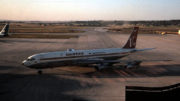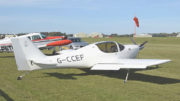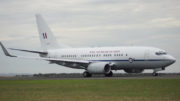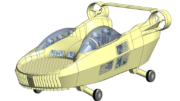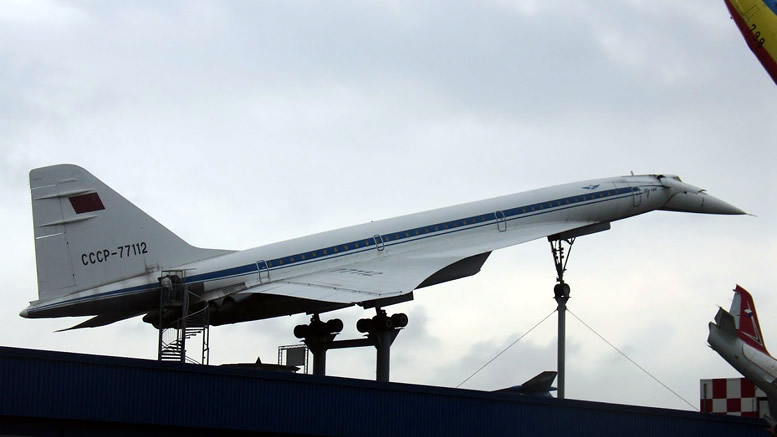
A result of the Cold War’s technology rivalry when the Soviet Union copied many things the west made, the Tupolev TU-144 was built as a competitor to the Anglo-French Concorde, and was one of the Soviet’s least successful project. Rumoured to be designed with the help from modified plans stolen from the French, and incorporating design elements from an unrealised soviet bomber project, it was the first supersonic commercial aircraft, beating Concorde by two months.
From the start of the program, the TU-144 (or Concordski as the media called it) was developed mainly as a vanity project to be a bit better than what the west could do. On paper, the TU-144 could hold 40 more people than the Concorde and was slightly faster, but it used more fuel and had less range. With a directive to be in the air first, the program suffered several technical issues that overworked the design team, who would have been better off working on a more sensible passenger jet aircraft. In the end only 17 TU-144’s including 1 prototype and 5 TU-144D models were built, while there were 16 production and 4 prototype Concorde’s built, 14 of which went on sale to Air France and British Airways. Only the Soviet state airline, Aeroflot, used the TU-144 on a limited passenger run that amounted to only 55 half full flights. Reportedly, the experience in flight was less than pleasant. Hot and noisy, several parts of the plane like tray tables, toilets and window blinds were often also broken.
While at first glance the TU-144 does bear a striking resemblance to the Concorde, there are quite a few differences. The TU-144 was designed around beating the Concorde, but with the technology the Russians had at the time. With this in mind, the TU-144 was designed to be longer and wider to fit more passengers. Instead of the Rolls-Royce engines that were specifically designed for the Concorde, early TU-144s made use of the already developed Kuznetsov NK-144 engines, these ended up being a fairly inefficient but albeit a faster choice. The latter built TU-144D series used the better performing Kolesov RD-36-51 turbojet, which was also used in soviet military applications. While the delta wing looks similar on both aircraft, it was found on the prototype that the TU-144 wing design was unstable at low speed, resulting in the need for retractable canard wings to be added to the front of the TU-144. A much simpler droop snout was used on the TU-144 also, along with less advanced breaks and a lack of thrust reversers, resulting in the need for the TU-144 to require parachute breaking. The much heavier TU-144 also used 18 wheels compared to Concorde’s 10. Some suggest this was required due to poor Soviet rubber of the tyres, but it was mostly about the innovative design of trying to retract smaller wheels between the engines, which needed to be much closer to the fuselage than those of the Concord.
The program’s first disaster was when a TU-144 crashed in front of TV-cameras during a presentation at the Paris Air Show in 1973. Several theories exist on why the crash occurred, with the main issue being the TU-144 pilot deviating from the planned display. At the same time, the French had sent up a Mirage III jet to photograph the TU-144 in flight, but did not tell the Russians. It is alleged the TU-144 found itself on a collision course with the Mirage, and when they took an evasive climb action, the plane stalled causing the crew to attempt a recovery from the stall that over stressed the air frame, eventually causing the plane to break up and crash. Alternatively it was also suggested that the pilot who was under pressure to show off the plane’s abilities against the Concorde, possible was pushing the plane too hard when he attempted the steep climb that caused the stall.
With all the bad press from the accident, the Soviets wanted to prove the plane was safe before the planned start of commercial service in 1977, so the TU-144 was first put into service on mail and cargo runs in 1975 using the TU-144S model. After several modifications and improvements, the TU-144D eventually began its short-lived passenger service across the sparsely populated region between Moscow and Almaty in Kazakhstan. A second crash during a test flight soon after passenger service began put commercial service on hold again in 1978. While a third emergency landing after an engine failure in 1980 sealed the fate of the TU-144, with the project eventually cancelled in 1983. The USSR government did allow for test flights and the TU-144 was used for the soviet space shuttle pilot training and high altitude lab tests post commercial service, with the last jet to fly in 1985.
The TU-144 flew again in the mid-1990s, when Boeing and NASA partnered with Tupolev to test supersonic flight. Using a heavily modified TU-144D, renamed TU-144LL and set up as a flying test laboratory for future supersonic development. Developed for NASA’s High-Speed Civil Transport program, it made 32 flights up to 1999 near Moscow. Since then, Boeing has shelved plans for a supersonic plane, deciding to continue improvements on their 777 series jets. NASA’s part in the project has also stopped, as their hopes for large scale use of supersonic aircraft had proven too costly.
The TU-144 was a weird curiosity of Soviet and Western rivalry, despite its reliability issues and the challenges faced with using less advanced technology it did manage to outperform the Concorde in some respects. However, one aspect they both shared was the flawed logic that supersonic passenger jets were the going to be the next big thing. Rising oil prices in the 1970s put an end to any dreams of supersonic planes being mainstream. At least the Concorde did have a long career serving as a rich persons bragging piece, something the TU-144 was never designed to be. Many involved in the TU-144 project also lament that all funds poured into the supersonic jet would have been better off placed into other normal passenger jets that were under development at the time.
Despite the failure of the TU-144, Tupolev (the Russian company behind the TU-144 and Buran space shuttle) were hopeful to forge ahead with plans to build the next-generation supersonic plane. A larger TU-244 passenger jet and a smaller TU-444 business jet have been proposed in the years since the TU-144 was mothballed. With not much interest from airlines, it is expected that the funding that Tupolev need to build their next supersonic passenger jets will never come, and their dream will never go further than the plastic model in their boardroom.
By: Gary Watts

